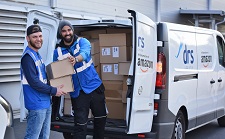Amazon fills in the ‘e-commerce logistics & delivery’ jigsaw puzzle

Amazon’s well-publicised planned test-launch of third-party deliveries in the US is the latest piece in a jigsaw puzzle that could create a unique model of integrated e-commerce logistics and delivery operations in countries around the world.
The global e-commerce leader is steadily reducing its reliance on external logistics and delivery partners by building up in-house capabilities, ranging from warehousing and linehaul transportation to final-mile deliveries. Although largely in the US so far, parts of this model are being replicated in Europe and India, as well.
As various experts and analysts have pointed out, Amazon wants to reduce its high third-party shipping costs by creating its own logistics network that would benefit from extensive economies of scale and could generate significant revenues by offering logistics and delivery services to other businesses. Even if it is not realistic to completely replace major providers such as UPS, FedEx and USPS, Amazon could divert substantial volumes into its own network in future.
Amazon, with net sales of $178 billion in 2017, saw its overall ‘fulfilment’ costs soar by 43% to over $25 billion last year. In the peak fourth quarter, Amazon’s ‘fulfilment’ costs increased by 57% to $8.97 billion while worldwide shipping costs went up by 31% to $7.4 billion in the quarter, its 2017 results showed.
Amazon already leverages its continually expanding network of warehouses through its logistics outsourcing service Fulfillment by Amazon (FBA). Third-party merchants store products in Amazon's fulfillment centres, and the e-commerce company is responsible for picking packing and shipping, as well as providing customer service for these products.
FBA “shipped billions of items for small and medium-sized businesses selling on Amazon worldwide” last year, the company said in its 2017 results announcement. In 2016, the figure had been two billion items. Many of these products qualified for free shipping through the Prime customer loyalty scheme. Overall, more than five billion items were shipped with Prime worldwide in 2017.
Amazon is now expanding the service by launching tests of 'Fulfillment By Amazon (FBA) Onsite'. Under this service, merchants keep goods in their own stores but use Amazon for the remaining logistics, and also benefit from the company’s low negotiated rates with delivery companies. Amazon already offered Seller Fulfilled Prime, which lets sellers ship Prime-eligible products directly from their own warehouses but this does not include the low shipping rates.
“This groundbreaking program offers the best parts of Fulfillment by Amazon and Seller-Fulfilled Prime. Your inventory remains in your facility and orders are fulfilled through Amazon’s transportation network,” the company told about 50 US-based sellers in a message inviting them to test the scheme. Apparent benefits include faster time to market by cutting out the Amazon warehouse stage.
In the latest move, reported by The Wall Street Journal last week, a new ‘Shipping with Amazon’ (SWA) service would offer third-party merchants with their own warehouses the option of contracting the e-commerce giant to collect and deliver shipments on their behalf. The main differences between FBA Onsite and SWA were not immediately clear. However, this could just be a testing-ground for SWA which could be extended to other business customers in future, according to the article.
Amazon plans to test the service initially in Los Angeles and then gradually expand it to other US cities, according to media reports.
Under CEO Jeff Bezos, Amazon has been steadily building up an asset-based transportation network to operate such a logistics and delivery service in the US. This includes the subcontracted fleet of Prime Air planes that flies shipments across the country and dedicated trucks to transport shipments to fulfilment centres and delivery stations.
The most complex and costly part, however, remains final-mile delivery, which is mostly outsourced to large delivery companies. In the US, Amazon relies on USPS, UPS and FedEx for the bulk of its deliveries while it uses a mix of postal and parcel carriers in European markets.
In parallel, however, Amazon has built up its own delivery operations, using subcontracted regional courier companies in several countries, including the US, the UK and Germany.
In addition, it is testing the crowdsourced model with the launch of Amazon Flex, which uses self-employed part-time workers to deliver parcels for hourly payments on a flexible basis. Amazon Flex is now operating in more than 50 US cities and has also launched in the UK, Spain (Madrid, Barcelona, Valencia), Germany (Berlin) and Singapore.
As alternative delivery points, the company is rolling out Amazon Lockers in several countries, including the US, the UK, Germany, France, Italy and Spain, testing home collection boxes called ‘The Hub’ in the US, and, mostly recently, starting testing in-home ‘Amazon Key’ deliveries in the US as well.

